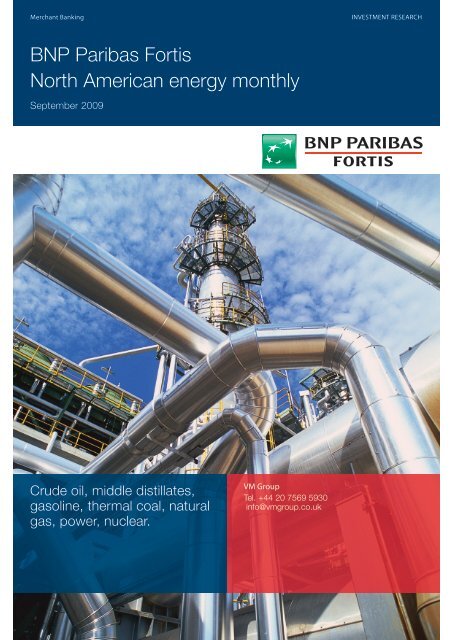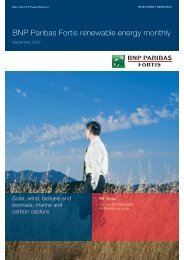BNP Paribas Fortis North American energy monthly - Virtual Metals
BNP Paribas Fortis North American energy monthly - Virtual Metals
BNP Paribas Fortis North American energy monthly - Virtual Metals
- No tags were found...
You also want an ePaper? Increase the reach of your titles
YUMPU automatically turns print PDFs into web optimized ePapers that Google loves.
Merchant BankingINVESTMENT RESEARCH<strong>BNP</strong> <strong>Paribas</strong> <strong>Fortis</strong><strong>North</strong> <strong>American</strong> <strong>energy</strong> <strong>monthly</strong>September 2009Crude oil, middle distillates,gasoline, thermal coal, naturalgas, power, nuclear.VM GroupTel. +44 20 7569 5930info@vmgroup.co.uk
<strong>BNP</strong> <strong>Paribas</strong> <strong>Fortis</strong>/VM Group September 2009 | <strong>BNP</strong> <strong>Paribas</strong> <strong>Fortis</strong> <strong>North</strong> <strong>American</strong> <strong>energy</strong> <strong>monthly</strong> | 1ContentsAnalysis 2Focus 5Hedge funds activity 8Crude oil 9Middle distillates 10Gasoline 11Steam coal 12Natural gas 13Power 14Nuclear 15Disclaimer and copyright 16About VM Group 17<strong>BNP</strong> <strong>Paribas</strong> <strong>Fortis</strong> Bank <strong>North</strong> <strong>American</strong> <strong>energy</strong> <strong>monthly</strong> is an exclusive<strong>energy</strong> research joint venture between <strong>Fortis</strong> Bank SA/NV and VM Group.
<strong>BNP</strong> <strong>Paribas</strong> <strong>Fortis</strong>/VM Group September 2009 | <strong>BNP</strong> <strong>Paribas</strong> <strong>Fortis</strong> <strong>North</strong> <strong>American</strong> <strong>energy</strong> <strong>monthly</strong> | 3and crude oil prices has been the subject of intense debate and considerablemarket speculation. Chanting a mantra of “gas prices will rise soon” might offersome solace to the most loyal natgas investors, but the realities come down toeconomic performance, weather forecasting and the actual amount of gas held instorage.Rebound in rig activityOne of the explanations for the disconnection between natgas and crude oilprices is that while demand for gas has slackened, production has yet to bereined-in. The Baker Hughes rig count for active gas rigs in the US has beencreeping up slowly in recent weeks, suggesting that demand for gas is going topick up soon. By the start of September, the gas rig count had recovered to 699,from 677 in early August; that’s still way off the dizzy heights of 1,606 a yearago, but despite that, natural gas in storage in the US at the end of Augustamounted to 3,258bn cubic feet (bcf), which represented an 18.8% increase overthe same time last year and an equally-depressing 18.1% rise over the five-yearaverage.Total gas storage capacity can be calculated in a number of ways. It variesaccording to the number of depleted reservoirs in oil and/or natural gas fieldswhere it can be stored, and the number of aquifers and salt cavern formationsavailable to producers. Storage sites also vary in terms of porosity, permeability,retention capability, maintenance costs, deliverability/injection rates, cyclingcapability, and proximity to market. Nevertheless, for the sake of analysis, theestimate of 3,789 bcf storage capacity made by the Department of Energy lastyear is a sensible benchmark to use, although the actual figure may be about 5%higher, almost 4,000 bcf. Calculating on this basis, current gas in storageamounts to only 86% of total capacity, undercutting the idea that the US isreaching total capacity through overproduction and slack demand.Weather dimensionSignificant drawdowns on this natural gas in storage typically begin inNovember, just ahead of the winter heating market which technically runsthrough to March, but can be buffeted by an early cold snap or early springweather. The subsequent refill season runs from April to October.Long-range forecasts by the National Weather Service branch of the NationalOceanic and Atmospheric Administration (NOAA) point to a relatively warmfinal three months of 2009, but that the probability of warmer-than-normaltemperatures brought about by the expected impact of the El Niño-SouthernOscillation decrease significantly through to April 2010. NOAA also suggests:“the enhanced probability of above-median precipitation due to El Niño extendsinto the southern plains in October-December 2010 and across the entiresouthern US during the winter seasons.”That’s one view. On the other hand, the weather forecasting serviceAccuWeather predicts, in more prosaic language, that “the current El Niño willfade over the winter and will probably not play as much of a role in the overallweather pattern as might be expected in a typical El Niño year. The areas thatwill be hit hardest this winter by cold, snowy weather will be from New Englandthrough the Appalachians and mid-Atlantic, including <strong>North</strong> Carolina. Areasfrom New York City to Raleigh have gotten by the past two years with verylittle snowfall. This year these areas could end up with above-normal snowfall.”AccuWeather forecasts snow fall totals of between 50-100 inches (1.25m-2.5m).Two forecasts, two different outlooks: but the common thread seems to be thatthe coming winter months will be warmer and wetter than normal, in allprobability delivering wide-scale snow across much of the traditional natural gasheating market. The likelihood is that the 2009-2010 winter heating season willonly make a slightly bigger than normal dent in available gas supplies.
4 | <strong>BNP</strong> <strong>Paribas</strong> <strong>Fortis</strong> <strong>North</strong> <strong>American</strong> <strong>energy</strong> <strong>monthly</strong> | September 2009 <strong>BNP</strong> <strong>Paribas</strong> <strong>Fortis</strong>/VM GroupEconomic recoveryThat leaves only the economic performance of the US as the remaining factor inboosting demand for natural gas. And here of course there is as much divergenceof opinion as there is about the likely depth of snowdrifts in Manhattan inFebruary. Much of this variance in outlook has been tinged with theunderstandable caution of not wishing to call the end of the recession, for fear ofgetting it badly wrong. Instead, economic analysts and politicians continue totiptoe through the data and conclude that a “maybe yes” or a “maybe no” willsuffice.Even the White House, which would normally be triumphant over every scrap ofpositive economic news, has pulled its punches. When announcing in lateAugust Ben Bernanke’s appointment as chairman of the US Federal Reserve fora second term, President Obama, looking like a mourner at a funeral, cautionedthat the US had a long way to go before full economic recovery – which ofcourse is not the same as saying that the recovery has started.A few days earlier, Bernanke ventured that the economy seemed to bestabilizing and that economic growth was on the near horizon. “Economicactivity appears to be leveling out in the United States and abroad, and theprospects for a return to growth in the near term appear good,” Bernanke said.What else can they say about a national recession, when millions of US familieswill have to contend with their own personal recessions well into next year?Aside from a public unwillingness to say the worst is over, the US governmentmust be breathing a sigh of relief at the state of the economy compared to whatexisted just nine months ago.Expected upturnIn this vein, it is our view that the economic downturn in the US bottomed out inJune and that the recession in fact lasted just 19 months. There is alreadyconsiderable economic data to support this position. Furthermore, the severalhundred billion dollars in genuine economic recovery funds that Obama startedto inject into the economy earlier this year will prevent a double-dip to thedownturn. When this becomes more widely accepted, the absurdly low pricesthat natural gas will fetch in September and October will become lostopportunities for speculators. Instead, prices will rebound closer to $5/MMBtubefore the end of the year and back to $7/MMBtu during the coldest wintermonths.The collapse of natural gas prices during the first nine months of 2009 will havean unexpected impact on US <strong>energy</strong> markets in the years ahead. Shale gas isnow a serious contender and will become more widely accepted as“conventional” gas production, while the prospects of huge natural gas reservesbeing delivered to the contiguous US through Canada will guarantee asignificant role for natural gas as a substitute for coal and an alternative tonuclear power. Of course, no utility board in their right minds is going to makeinvestment decisions about gas-fired power plants on the basis of prices set at$2.75/MMBtu. But, once price stability has returned to this sector, natural gaswill receive a far greater degree of serious attention than it has in the past.
<strong>BNP</strong> <strong>Paribas</strong> <strong>Fortis</strong>/VM Group September 2009 | <strong>BNP</strong> <strong>Paribas</strong> <strong>Fortis</strong> <strong>North</strong> <strong>American</strong> <strong>energy</strong> <strong>monthly</strong> | 5FocusAnalyst: Paul HannonVM GroupTel: +44 20 7569 5930Email: paul@vmgroup.co.ukPresident Roosevelt signing the TennesseeValley Authority Act in 1933Source: Tennessee Valley AuthorityWatershed for the TVAA management shake-up, or even privatization, is urgently needed at the largestutility in the US.Very few power utility executives know how to eat humble pie in public, butTom Kilgore made a good stab at it in late July. Kilgore acknowledged that theTennessee Valley Authority (TVA), once the crown jewel in F. D. Roosevelt’srecovery scheme of the 1930s, now suffered from a lack of accountability, poortraining, poor communication and an overall lack of management quality. Theoperational culture of the TVA, Kilgore admitted, had to change and a majormanagement overhaul has been set in motion.As welcome as his self-criticism was in front of the House Subcommittee onWater Resources & Environment, Kilgore had presided over one of the worstenvironmental incidents in the history of the TVA. The issues raised by it arecalling into question the future shape of the 76-year-old federal agency.It all started a few days before last Christmas 2008, when 5.4m cubic yards oftoxic coal ash broke through an earthen dike at the 1,700 MW coal-firedKingston Fossil Plant, 40 miles west of Knoxville, Tennessee. The deluge ofcoal ash poured into the nearby Emory River and cascaded over several hundredacres of adjoining lakeside community. This was an environmental disaster thatshould not have happened, especially since warnings had been given about itmore than a decade ago. Fortunately, no one died in the initial incident, but aclean-up contractor was killed in July while unloading pipe for the dredging ofthe Emory. Current TVA estimates of the cost of the clean-up were revised inlate August to more than $1.2bn over three years, but this does not take intoaccount any of the legal settlements that may result from a series of lawsuitslaunched against the agency for the disaster.In addressing Congressional investigators, Kilgore admitted: “We have tochange. If that means heads have to roll, if people have to leave, so be it.” Ofcourse, expecting Kilgore to resign is the equivalent of asking for the resignationof the chairman of the White Star Line following the sinking of the Titanic. Itwill not happen. Nor should it. Kilgore is a hard-worn industry professional,who became chief operating officer of the TVA in 2005 after a lengthy career in<strong>North</strong> Carolina-based Progress Energy, where he was responsible for fuelextraction, merchant generation and <strong>energy</strong> marketing. A year after joining theTVA, he became its first chief executive officer. The root causes of the coal ashdisaster predate Kilgore’s arrival at the utility, and the report by the TVA’sinspector general laid the blame on a deep-seated malaise in the organization. Ineffect, the report said that this disaster was created by the TVA and could havebeen prevented, if normal safety management procedures had been followed.Move to dry ash storageSince the coal ash disaster, the TVA has said it would consider closing some ofits older coal-fired power units. However, this is more of a reflection of theircomparative old age and the fact that the utility has been ordered to install $1bnworth of pollution upgrades by 2014, rather than any aversion to using coal as afuel source. As for the coal residues produced by its existing plants, the TVAannounced in early August that it would convert all coal waste and gypsumoutput to dry storage. Six of the utility’s coal-fired plants operate on a wet ashsystem, whereby unburned by-products are washed out with water and stored inwater-filled containment areas, like the one at Kingston. With dry ash, vacuumsystems gather the waste into silos, where it can be stored on site or freighted toa regional storage depot. The bill for this switch to dry ash storage is put at $2bn.But such actions are grouped into the category of closing the stable door afterthe horse has bolted. Instead, there are larger issues at stake and, in a politicalenvironment where established orthodoxies are being challenged daily, someone
6 | <strong>BNP</strong> <strong>Paribas</strong> <strong>Fortis</strong> <strong>North</strong> <strong>American</strong> <strong>energy</strong> <strong>monthly</strong> | September 2009 <strong>BNP</strong> <strong>Paribas</strong> <strong>Fortis</strong>/VM Groupshould ask the basic question – why in a modern market economy does the USgovernment own the largest power utility in the country? And if the Obamaadministration decided to sell all or part of the TVA, how much would it raise?Age of coal plants in southern USUtility average ageYearsDiverse power mixThe TVA takes every opportunity to remind people that it is the nation’s largestpublic power provider and that it is completely self-financing. It provides powerto large industries and 158 power distributors that serve 9m consumers in sevensoutheastern states. It also manages the Tennessee River and its tributaries and isresponsible for flood damage reduction, navigation, water quality, and recreationfacilities. As a flagship utility, the TVA has few rivals. The agency operatesthree nuclear power plants, 11 coal-burning plants, 29 hydroelectric dams, sixgas turbine units and one pumped-storage plant. In line with most other USutilities, the TVA is moving into renewable <strong>energy</strong> and currently runs 16 solarpowered sites, one wind-<strong>energy</strong> site, and a methane gas facility. Even though ithas this attractive mix of fuel sources, coal still accounts for about 60% of TVAgeneration, with nuclear contributing 30% and hydro a further 10%.Tennessee Valley Authority 47.1Duke Power in Carolinas 43.7Kentucky Power 41.5Appalachian Power 40.3Progress Energy Carolina 35.7Alabama Power 34.9Georgia Power 34.4Source: Tennessee Valley Authority(TVA's coal-fired plants, on average, are the oldestof any Southern utility)Overview of TVA coal-fired plantsNumber ofunitsWinter NetCapacity,megawattsAllen 3 753Bull Run 1 870Colbert 5 1,198Cumberland 2 2,530Gallatin 4 988John Sevier 4 712Johnsonville 10 1,254Kingston 9 1,456Paradise 3 2,273Shawnee 10 1,369Widows Creek 8 1,629Source: Tennessee Valley AuthorityDespite its heavy reliance on coal generation, the TVA is faced with a long-termissue of plant renewal. With an average overall age of 47 years, the TVA fleet is10 years older than its competitors in the south. The youngest TVA coal-firedplant is 40 years old, and the eldest is 60. Old and dirty they may be, but thesepower plants are hugely profitable examples of the industry’s Golden Years,where all the original capital costs have been repaid and the income stream isimmense. Even with this income stream, however, the latest TVA budgetannouncement had some of the hallmarks of a company in trouble, as the boardannounced a $7.2bn shortfall for 2010-2012, additional borrowing of $2.8bn (asa result of the Kingston disaster) and $1.9bn in budget cuts. For an organizationwith revenue of $10.4bn and operating income of $2.2bn for 2008, this collapsein its finances is remarkable.The TVA has a statutory long-term debt limit of $30bn and, even with a decadeof chipping away at this, current debt stands at just over $20.4bn. Total balancesheet assets for 2008 are stated at $37bn, with property, plant and equipmentaccounting for $25.8bn. Nevertheless, the agency has large-scale commitments,such as the $1.5bn completion of the Watts Bar Unit 2 nuclear reactor, and atleast $1bn in pollution control costs trigged by a <strong>North</strong> Carolina state lawsuit.Any buyers?But the questions remain. Who would buy TVA assets and how much wouldthey fetch? First of all, no single organization could purchase the TVA outright,as a price tag in the range of $75bn-$80bn would be necessary. Nevertheless,some of its assets could be sold piecemeal. For example, the TVA’s nuclearpower division, which was created in the 1970s, could realize $10bn-$15bnalone. The agency’s unfinished Bellefonte nuclear plant in Alabama could be anattractive piece of property to an established nuclear power generator, at a timewhen the nuclear renaissance in the US might be beginning to stall.As for the TVA’s hydroelectric assets, they are unique and cannot be replaced inthe same manner that a coal-fired station or a nuclear power plant site can beextended to accommodate additional capacity. Given that there is little furtherexpansion possible for hydroelectric power in the region, the agency’s extensivedam network should command a premium.However, as already noted, the aging profile of its coal-fired capacity means thatthe TVA’s primary source of power is coming to an end and will need to bereplaced or upgraded over the next 15 years. Whether the utility decides toconvert existing sites to natural gas generation or builds entirely new gas plantswill be one of the tough decisions Kilgore and his board will have to take in thecoming years.
<strong>BNP</strong> <strong>Paribas</strong> <strong>Fortis</strong>/VM Group September 2009 | <strong>BNP</strong> <strong>Paribas</strong> <strong>Fortis</strong> <strong>North</strong> <strong>American</strong> <strong>energy</strong> <strong>monthly</strong> | 7If a break-up of the TVA is not feasible, there is no reason why the utility couldnot raise capital through an initial public offering (IPO) on the New York StockExchange. Once the TVA was reconstituted as a public company, an IPO couldput about 20% of its shares on the market and might raise about $5bn in currenttrading conditions, or possibly much more, when Wall Street has regained itsappetite for risk.Democrat iconFew would dispute that the TVA has a unique standing in <strong>American</strong> history. Itsymbolizes the triumph of heroic engineering over adversity, of rebuildingAmerica when it was at its weakest. And for that reason it has been very close tothe hearts of every Democrat since 1933. But not everyone has seen it like this.For many Republicans, it is a constant reminder of the close brush withsocialism that America had under Roosevelt. During the 1964 US Presidentialcampaign, Republican Barry Goldwater famously said he would sell the TVAfor a dollar if necessary. That suggestion got some resounding cheers from thetraditional Republican heartland in the south, but Goldwater discovered to hiscost that Tennessee voters were wedded to the idea of the government runningthe agency, even if it did smack of socialism. Goldwater faded into history butthe TVA continued on.Ultimately, the decision whether or not to privatize the TVA will be politicalrather than economic. As Goldwater discovered 45 years ago, there are fewvotes in abolishing the TVA, but there might be some merit in taking a veryclose look at how the organization is constituted. In trying to rally the US Senateto pass his cherished climate change bill, President Obama urged Republicans:“We cannot be afraid of the future, and we must not be prisoners of the past.”This is a good enough reason for the TVA to be put under the microscope today,and why an entirely new future should be set out for it.
8 | <strong>BNP</strong> <strong>Paribas</strong> <strong>Fortis</strong> <strong>North</strong> <strong>American</strong> <strong>energy</strong> <strong>monthly</strong> | September 2009 <strong>BNP</strong> <strong>Paribas</strong> <strong>Fortis</strong>/VM GroupHedge funds activityHedge funds by number and AUM121086420-2-4-6-8Jan-08 May-08 Sep-08 Jan-09 May-09All hedge fundsAll with some commodity investmentFunds with >50% AUM in commoditiesSource: VM Group from Barclay Hedge FundDatabaseMonthly returns of hedge funds (%)3020100-10-20-30Jun-07 Dec-07 Jun-08 Dec-08 Jun-09Funds with >50% in <strong>energy</strong>Reuters CRB <strong>energy</strong> indexSource: VM Group from Barclay Hedge FundDatabaseNews• Sept 2 nd : A group of 30 hedge funds analyzed by Thomson Reuters increasedtheir exposure to the financial sector in the US by 56%, to $59.5bn, in Q22009 compared to Q1.• Sept 2 nd : The CFTC said it would publish its first expanded Commitment ofTraders’ report on 3 rd September. This follows an undertaking by the CFTCin July to use the report to provide more detailed information about positionsheld in commodity trades on US exchanges.• August 21 st : The UK Financial Services Authority (FSA) commissioned acost study of the European Directive on hedge fund regulation. The study isseen as part of UK efforts to have the proposal redrafted to be less punitive.The Spanish Presidency of the EU is expected to delay until 2010 any re-draftof the proposed Directive, which is backed by France and Germany butopposed by Sweden and the UK.Analysis• Returns steadily improve but risk of biasHedge funds in our sample, and those invested in commodity strategies, had abit of a performance wobble in June, but July data shows a return to the uptrend;in the first seven months of 2009 average returns remained positive, at1.6%. But does this reflect a strengthening industry, or is it more a result ofsurvivor bias? Redemptions and closures have slowed appreciably and, as theindustry continues to consolidate, it should be easier to tell if an improvingoverall pictured is based on genuinely more robust strategies rather than causedby the exclusion of those funds that have closed business and thus have droppedout of the statistical database. During July, average hedge fund returns improvedto 1.7%, from 0.17% the previous month. Funds with commodity exposure didbetter than the average, returning 1.8%, while those with more than 50% of theirmoney devoted to commodities surged ahead of the rest, returning 4.19%. Thosechoosing to place their bets with a specific sector fared less well: <strong>energy</strong> fundswere still showing negative returns, being on average down by 0.35%. Funds inmetals also remained in the red, at a negative 0.5%, while those in softsmanaged to climb into positive territory, by 0.6%.OutlookIt seems the threat of higher taxes will get hedge funds moving faster thananything else. Long before the EU finally reaches some sort of legislativeconsensus on what to do about hedge funds and their trading activities, thehills are alive with the sound of marching funds – as much as $15bn worthof hedge fund money has migrated from the UK to Switzerland in the past12 months. This flow of funds and their money is expected to continue, asfund managers seek to avoid the imposition of new tax legislation, whichwill see individuals in the UK earning in excess of £150,000/year facing a taxrate of 51%. Any new EU Directive seeking to throw much greatertransparency responsibilities onto hedge funds will merely speed the exodusof funds.
<strong>BNP</strong> <strong>Paribas</strong> <strong>Fortis</strong>/VM Group September 2009 | <strong>BNP</strong> <strong>Paribas</strong> <strong>Fortis</strong> <strong>North</strong> <strong>American</strong> <strong>energy</strong> <strong>monthly</strong> | 9Crude oilNymex WTI crude ($/bbl)757473727170696867666531-Jul 10-Aug 18-Aug 26-AugAug-09Source: Reuters EcowinICE Futures Brent crude ($/bbl)77767574737271706968Sep-0931-Jul 10-Aug 18-Aug 26-AugAug-09Source: Reuters EcowinSep-09US crude oil stocks (ex strategic reserve),(million barrels)390,000370,000350,000330,000310,000290,000270,000250,000Sep-08 Nov-08 Feb-09 May-09 Aug-09Source: Reuters Ecowin2008/2009 2007/20082006/2007News• Sept 2 nd : The US Energy Information Administration is reported to bepreparing to expand the data it publishes on <strong>energy</strong> markets in order toincrease transparency in oil and natgas trading.• Sept 2 nd : BP announced a major deepwater discovery in the Gulf of Mexico.• Aug 28 th : The number of oil and gas rigs active in the US in August rose by33 to 999, compared with 2,031 a year ago, according to Baker Hughes.• Aug 27 th : The oil industry celebrated the 150th anniversary of Colonel EdwinDrake striking oil in Titusville, Pennsylvania.• Aug 26 th : Pemex said it expects Mexican oil production in 2010 to fall to2.5m b/d, a drop of 4% from 1H 2009.• Aug 20 th : The US State Department approved the construction of the 450,000b/d 1,000-mile Alberta Clipper pipeline.• Aug 20 th : Chevron announced plans to build a solar power plant that willproduce steam to boost output at its aging Coalinga oilfield in California.• Aug 19 th : Pemex said it was seeking bids to drill 200 onshore oil wells in thesouth of the country over the next three years.Analysis• Paying the piperAs the major oil companies open the financial spigots once again, Washingtonlobbyists are enjoying one of their best periods in recent memory, according tothe latest figures provided by the non-profit research group Center forResponsive Politics. Flush with bumper profits from 2008, the leading oil groupsare getting their message across on issues such as climate change and the folly ofimposing new taxes on their exploration and development. So far the biggestspenders in 1H 2009 have been ExxonMobil ($13.6m), Chevron ($12.8m) andConocoPhillips ($9.2m). Collectively the oil and gas sector spent $82m makingits presence felt in Congress in the first six months, but what is perhaps moreinteresting are those companies that have not felt the need to lobby nationalpoliticians on industry issues. Among the household names that have not dippedinto their budgets to sway politicians this year are Baker Hughes, Schlumberger,Rockies Express Pipeline, Neste Oil and StatoilHydro. 1The Castro brothers have a good sense of timing, as witnessed by theannouncement in late July that state oil company Cuba Petroleo and Russian oilcompany Zarubezhneft had agreed contracts for oil exploration in the Cubanzone of the Gulf of Mexico. While US oil majors to the north and technologystrappedMexico to the west looked on with envy, the Cubans are getting onwith it in their own way. The Russians reputedly have been allowed to cherrypickthe best 15 available offshore exploration blocks, but the announcement byRussian Deputy Prime Minister Igor Sechin gave no details. Once the Russiansdiscover oil, which they undoubtedly will do over the next five years, theremaining part of the jigsaw will be refinery capacity. All eyes are turning tofurther upgrades to the Cienfuegos refinery in Cuba, PDSVA’s 1.2m b/d refinerycapacity in Venezuela and the new Pemex refinery plans for Mexico.OutlookOpec should feel satisfied with current crude oil prices, given that they onlyhad to resort to production cuts once this year. With prices hoveringaround $70/bbl in a period of economic uncertainty, it can look forward tosteadily higher prices once the economic recovery becomes full-blown. Weexpect another $10 increase in prices before the end of the year, andprovided the cartel maintains discipline over production quotas, that shouldeasily be achieved.1 http://www.opensecrets.org/lobby/indusclient.php?year=2009&lname=E01&id=
<strong>BNP</strong> <strong>Paribas</strong> <strong>Fortis</strong>/VM Group September 2009 | <strong>BNP</strong> <strong>Paribas</strong> <strong>Fortis</strong> <strong>North</strong> <strong>American</strong> <strong>energy</strong> <strong>monthly</strong> | 11GasolineNymex RBOB gasoline ($/gallon)2.102.052.001.951.901.851.8031-Jul 10-Aug 18-Aug 26-AugAug-09 Sep-09Source: Reuters EcowinUS pump gasoline ($/gallon)2.722.702.682.662.642.622.6007-Aug 14-Aug 21-Aug 28-AugSource: Reuters EcowinUS gasoline stocks (million barrels)245235225215205195185175Sep-08 Nov-08 Feb-09 May-09 Aug-092008/2009 2007/20082006/2007Source: Reuters EcowinNews• Aug 21 st : Travel on US highways rose 2% in the month of June to 256bnmiles, according to the Department of Transportation.• Aug 20 th : Cuban output of gasoline fell 36% to 232,000 tonnes in 1H,according to the National Statistics Office.• Aug 20 th : Fluor and ICA said they won a $638m contract to build an ultra-lowsulfur gasoline unit at the Cadereyta refinery in Mexico.• Aug 7 th : President Obama signed legislation providing an emergency $7bn forthe US Highway Trust Fund, keeping it solvent until the end of September.• Aug 6 th : The US Postal Service admitted it is examining a halt to Saturdaydeliveries, in a bid to cut annual gasoline consumption by 10.4m gallons.Analysis• EPA faces mileage conundrumResearchers at the Environmental Protection Agency (EPA) are struggling tocompile a new mileage rating for single fuel and multi-fuel vehicles. Faced withan eye-catching claim from General Motors about the 230 miles per gallon(mpg) fuel efficiency of its new Volt hybrid, the EPA realizes that the days ofthe single mpg rating are numbered and that a more sophisticated method ofmeasuring fuel efficiency is urgently needed. The computations become morecomplicated with pure electric vehicles, as witnessed by Nissan’s claim that itsnew all-electric Leaf model will achieve 367mpg. Nissan reached this figure byusing a benchmark of 82 kilowatt hours of electricity being the equivalent of oneUS gallon of gasoline. Using the Nissan methodology, the GM Volt’s citydriving fuel economy would fall back to 130mpg. Pending a review by aspecialist panel at the EPA, the most likely outcome will be a dual system,whereby mileage for gasoline consumption and electricity usage are publishedseparately.Just how far does $300m go? Apparently not as far as you would think whenyou learn that Energy Secretary Steven Chu authorized in late August that sumof federal funding for 25 cost-sharing projects that will put 9,000 alternative-fueland <strong>energy</strong> efficient industrial vehicles on <strong>American</strong> roads. In addition to partfundingthe light, medium and heavy-duty vehicles, the latest Chu spendinground, which forms part of the government’s Clean Cities program, also entailsestablishing 542 specialist refueling stops for these vehicles across the country.The vehicles and infrastructure will be based on the use of natural and renewablegas, propane, ethanol, biodiesel, electricity, and hybrid technologies. Estimatesby the Department of Energy suggest that up to 38m gallons of petroleum willbe displaced by this initiative. Chu obviously feels he has achieved value formoney, in that every government dollar spent will be matched by $2 fromparticipants in the vehicle program.Another sad reminder of the hectic expansion of the US ethanol industryoccurred in mid-August, with the filing by Altra Nebraska for Chapter 11bankruptcy protection. A half-built ethanol plant and $86m in liabilities are theremnants of the $200m Altra Nebraska project, which was designed to produce500m gallons of ethanol a year. Instead, high corn prices and a switch ofinvestor enthusiasm into other renewable fuels mean that the Nebraska facilitywill be dismantled in October and sold at auction. Estimates of the likely scaleof proceeds from the auction vary between $10m-$50m.OutlookGood news for drivers spells frustration for the refinery industry, becauseaverage nationwide gasoline prices of $2.63/gallon means there is barelyenough margin to keep refiners ticking over. In Nymex trading in earlySeptember, New York Harbor RBOB gasoline for October dropped 24cents to $1.80/gallon. Higher retail prices must kick in soon.
12 | <strong>BNP</strong> <strong>Paribas</strong> <strong>Fortis</strong> <strong>North</strong> <strong>American</strong> <strong>energy</strong> <strong>monthly</strong> | September 2009 <strong>BNP</strong> <strong>Paribas</strong> <strong>Fortis</strong>/VM GroupSteam coalNymex Central Appalachian coal ($/short ton)4847474646454544444331-Jul 10-Aug 18-Aug 26-AugAug-09Source: Reuters EcowinHWWA coal index (2000 = 100)285280275270265260Sep-0931-Jul 10-Aug 18-Aug 26-AugSource: Reuters EcowinNews• Aug 25 th : Georgia state officials issued draft permits for Plant Washington, aproposed 850 MW coal-fired power station near Sandersville.• Aug 24 th : South Carolina utility Santee Cooper suspended plans to build a600 MW coal-fired power plant, citing falling demand and the prospect offuture carbon regulation costs.• Aug 24 th : The US Bureau of Land Management published its finalenvironmental impact study on the proposed expansion of four coalmines inGillette, Wyoming.• Aug 12 th : Rio Tinto said it hopes to raise at least $500m through an initialpublic offering for its US subsidiary Cloud Peak Energy.• Aug 12 th : A Washington District Court halted a US government attempt tooverturn relaxed regulations on disposal of debris from mountaintop mining.• Aug 12 th : Peabody Energy said it expected coal exports to China to slow in2H 2009.Analysis• Miners compete for safety honorsIf it’s September it’s time for the annual US mine safety competition organizedby the Mine Safety and Health Administration agency (MSHA) of theDepartment of Labor. Contests are held every other year for coal and metal/nonmetalrescue, with this year’s coal competition taking place in Nashville,Tennessee. In the past, the contests have been hard fought and adjudicated to ahigh standard. The 2009 rulebook runs to 62 pages and covers the labyrinthinecomplexity of what might happen in a coal mining disaster. In the “field”competition, according to the MSHA, teams must solve a hypothetical mineemergency problem, while judges rate them on how well they adhere to minerescue procedures and how quickly they complete specific tasks. All good fununtil it needs to be put into practice.The search for a breakthrough in clean coal technology was given a $7m boostin late August when the US Department of Energy (DOE) picked seveninstrumentation research projects that will develop sensors and controls forcarbon capture and storage systems. Seven million dollars might not buy a lot ofinsight but the DOE feels it has focused on the most important areas that needfederal support. The research projects include advanced materials developmentfor high-temperature sensing, novel sensing devices for harsh environments,computer modelling for the placement and performance of sensors, andmodelling for gasification and combustion reactors. According to the DOE,future power plants are expected to be extremely complex and will require ahigh level of system integration. 3Falling demand for coal and uncertainty in the broader economy have promptedDakota Minnesota & Eastern Railroad to put on hold a $6bn plan to ship coalfrom the Powder River Basin in Wyoming to power plants in South DakotaMinnesota. Based in Sioux Falls, South Dakota, the Canadian Pacific Railwaysubsidiary announced in late August that it had decided to drop lawsuits againstlandowners that were impeding the progress of the scheme.OutlookThere were no signs of life in the spot coal market in August, with mostgrades remaining unchanged. In the short term, this sector will suffer whilenatural gas is being given away at about two-thirds the average cost ofproduction, but in the longer term, there is a litany of problems that coalproducers must face up to. Lower prices is just one of them.3 http://www.fossil.<strong>energy</strong>.gov/news/techlines/2009/09059-DOE_Selects_Sensors_and_Controls_P.html
<strong>BNP</strong> <strong>Paribas</strong> <strong>Fortis</strong>/VM Group September 2009 | <strong>BNP</strong> <strong>Paribas</strong> <strong>Fortis</strong> <strong>North</strong> <strong>American</strong> <strong>energy</strong> <strong>monthly</strong> | 13Natural gasNymex Henry Hub natural gas ($/MMBtu)4.504.304.103.903.703.503.303.102.902.702.5031-Jul 10-Aug 18-Aug 26-AugSource: Reuters EcowinAug-09Sep-09Nymex propane natural gas ($/gallon)0.980.960.940.920.900.880.860.840.820.8031-Jul 10-Aug 18-Aug 26-AugSource: Reuters EcowinAug-09Sep-09US natural gas in underground storage(billion cubic feet)4,0003,5003,0002,5002,0001,5001,000Sep-08 Nov-08 Feb-09 May-09 Aug-092008/2009 2007/20082006/2007Source: Reuters EcowinNews• Aug 31 st : Baker Hughes agreed a $5.5bn cash and stock takeover ofpressuring pumping specialist BJ Services.• Aug 20 th : Dallas-based Chief Oil & Gas sold a 30% stake in its MarcellusShale gas field to Enerplus Resources Fund for $406m.• Aug 10 th : Apache Corporation agreed to supply natural gas to the proposedKitimat liquefied natural gas export terminal in British Columbia.• Aug 5 th : Exco Resources sold half of its midstream assets in Texas andLouisiana to BG Group for $249m.Analysis• Pipeline groups make progress in AlaskaBP and ConocoPhillips may have been the first ones to blink in the greatAlaskan gas pipeline standoff, by revealing in mid-August they would delayapplying for certification from the Federal Energy Regulatory Commission(FERC) for its Denali project until October 2012. Nevertheless, the two majorssay they are still committed to holding an “open season” next year, during whichthey hope to secure agreements from gas producers to use their proposed line. Ifthe open season is well supported, FERC might be persuaded to support theDenali application. In the meantime, ExxonMobil and TransCanada arehammering out the detail of their proposed joint venture to build a rival route,which, with the latest Denali news, may be the winner in the race to build thefirst gas pipeline linking Alaska with markets in the Midwest. Either way, thechances of a pipeline actually being built have just increased.New rules from the Minerals Management Service allow for a five-yearextension of proprietary protection of seismic data held by the governmentagency. Effective 14 th September, the new regulations mean that in certaincircumstances companies can extend the current 25-year protection period to 30years, allowing them to reprocess old data using new technology and modelingsystems. The companies most likely to benefit from the rule change are thosewith geophysical data from the Outer Continental Shelf.Defying the odds at a time when natural gas prices have slumped, SempraEnergy’s $1.2bn Costa Azul terminal in northern Mexico began acceptingdelivery in late August of its first regular cargoes of LNG from Indonesia sinceit opened for business last year. Sempra expects to receive up to three shipmentsa month for the rest of the year, as part of a 20-year supply deal for output fromthe Tangguh offshore natural gas field. Under the terms of the agreement,Sempra’s suppliers can divert up to half of the LNG cargoes to other markets ifit can receive a better price elsewhere, while those cargoes actually delivered toCosta Azul are based on the price of natural gas in California.Amid the wreckage of the Alberta gas market, a few deals are still being done.One of the largest acquisitions in August was the takeover by DaylightResources Trust of Highpine Oil & Gas for C$530m (US$482m). With a marketcapitalization of about C$1bn, Daylight is strong on natural gas and wasattracted to Highpine’s solid cash flow from its light oil properties. Ironically, inmaking Daylight a more evenly balanced oil and gas company, its managementmay have increased the possibility of a takeover bid for itself. Elsewhere, DelphiEnergy agreed an all-paper takeover of Fairmount Energy for C$14.5m, plusC$8.7m in debt and transaction costs. The deal will give Delphi access to lowcost gas output in Alberta.OutlookA collapse in prices never inspires anyone but a pessimist. But mark thiswell – gas prices will rebound sooner than anyone expects and a price of$4.50/MMBtu is feasible by mid-October.
14 | <strong>BNP</strong> <strong>Paribas</strong> <strong>Fortis</strong> <strong>North</strong> <strong>American</strong> <strong>energy</strong> <strong>monthly</strong> | September 2009 <strong>BNP</strong> <strong>Paribas</strong> <strong>Fortis</strong>/VM GroupPowerNews• Aug 27 th : The US Justice Department and the state of Illinois filed a lawsuitagainst Midwest Generation for air pollution violations.• Aug 24 th : Southern US states could cut <strong>energy</strong> use by 9% by 2020 withaggressive <strong>energy</strong> efficiency programs, according to a Georgia Tech study.• Aug 20 th : New York State regulators approved the distribution of $95m forrenewable <strong>energy</strong> projects.• Aug 18 th : International <strong>energy</strong> business operator AEI filed an initial publicoffering with the New York Stock Exchange to raise $863m.Analysis• West Coast guessing gameTrying to guess the likely cost of building new power infrastructure in Californiahas become as sensible as striking a match in a firecracker factory. The latestattempt at this apparently pointless exercise was published in early August bythe Renewable Energy Transmission Initiative (RETI), a state-sponsored projectdesigned to find a solution to the hugely complicated transmission mishmash thelargest <strong>energy</strong> consumer in the US has developed. The RETI report concludesthat investment of $15.7bn will be necessary to build new lines and transmissioncorridors in areas yet to be agreed, but almost certainly popping up in theCentral Valley. This level of investment for a state on the verge of bankruptcyhas brought smiles to many faces, not least among officials in the CaliforniaPublic Utilities Commission, which had estimated in June the likely cost of newinfrastructure would be just $12bn. 4The sums involved are not large, but the most unusual deal of the month was theUS$5.4m acquisition of California-based solar power company CleantechAmerica by the New Zealand state-run power generator and retailer MeridianEnergy. Meridian already has a dominant position in hydro and wind power inNew Zealand and, according CEO Tim Lusk, the purchase of the small WestCoast company will give it valuable experience in developing small-scale solarpower projects in the Pacific. Cleantech America’s first major project will be a 5MW photovoltaic solar plant in Mendota, California. The plant, due to beoperational by the end of the year, will be the first utility-scale solar PV projectapproved by the California Public Utilities Commission under the state’sRenewables Portfolio Standard program. However, with so much US expertisein solar power, it is surprising that a New Zealand company would be the first toidentify the potential of the Pacific Island market.You’ve got to hand it to Pacific Gas and Electric (PG&E); it will look at anyform of <strong>energy</strong> that offers a whiff of profit. The latest venture the West Coastutility is examining is the relatively unknown field of compressed air <strong>energy</strong>storage (CAES), which entails forcing air into a geologically-safe undergroundcavern at times of low demand and drawing on the reserve to power turbineswhen demand picks up again. Although ideally suited to the intermittent natureof many renewable <strong>energy</strong> sources, there are only two operational CAESprojects in the world, but this is not stopping PG&E seeking a $25m federalgrant to study the feasibility of the technique in California.OutlookEconomic recovery is just around the corner, but no one will tell us whichcorner. Wait another six months and it will become obvious. The recessionhas hit bottom but the long slow upturn has only just begun. Data alwayslag real time events, but the power sector should expect a busy 2010.4 http://www.<strong>energy</strong>.ca.gov/2009publications/RETI-1000-2009-001/RETI-1000-2009-001-F.PDF
<strong>BNP</strong> <strong>Paribas</strong> <strong>Fortis</strong>/VM Group September 2009 | <strong>BNP</strong> <strong>Paribas</strong> <strong>Fortis</strong> <strong>North</strong> <strong>American</strong> <strong>energy</strong> <strong>monthly</strong> | 15NuclearUranium (U 3 0 8 ), 2008-2009(spot price, $/pound)70656055504540Sep-08 Nov-08 Feb-09 May-09 Aug-09Source: Reuters EcowinNews• Aug 11 th : Canada-based Uranium One agreed to pay Areva and Electricité deFrance $35m for their Malco joint venture in Wyoming.• Aug 7 th : The Tennessee Valley Authority said it had scaled back plans tobuild just one nuclear reactor at its Bellefonte site in Alabama.Analysis• The renaissance starts hereIt had to happen sometime, but August 2009 may go down in the history booksas the starting point for the renaissance of US nuclear power. On 11 th August,the Florida state cabinet approved certification of Progress Energy’s nuclearplant in Levy County, meaning that the state had taken a giant stride towardsconstruction of the first new nuclear station since 1976. Although the latestapproval related to site certification by the state, the sole remaining hurdle willbe approval by the Nuclear Regulatory Commission (NRC), which is likely tooccur in 2012. If construction finally starts on the Levy project, it will be one ofthe largest nuclear plants in the US. The cost of the 2,200 MW plant is estimatedto be $14bn, with a further $3bn earmarked for transmission infrastructure. Aspart of its drive to cut carbon emissions, Progress Energy had earlier committeditself to retiring two of its oldest coal-fired power plants in the state. GovernorCharlie Crist described the siting decision in Tallahassee as confirmation that“Florida is on the right path towards achieving <strong>energy</strong> diversity andindependence.”The much-delayed nuclear renaissance received a further shot in the arm on 26 thAugust, with the granting by the NRC of an “early site permit” to SouthernNuclear to build two nuclear reactors at its Vogtle site near Augusta, Georgia.Valid for 20 years, the permit means that the NRC is satisfied about safety andenvironmental issues and it will allow preliminary construction to start on thesite. State approval has already been granted for the two 1,100 MW reactorswhich are due to be operational by 2017 at a total cost of $14bn. A day later, theNRC issued its final safety evaluation report for the proposed renewal of theoperating licenses for Units 1 and 2 at the Susquehanna Steam Electric Station inPennsylvania, concluding there was no reason to refuse a license for a further 20years. The two units have a combined capacity of 2,275 MW.The pro-nuclear lobby also scored a publicity coup during August, whenColorado Democrat senator Mark Udall, formerly an opponent of nuclear power,joined forces with Arizona Republican senator and recent presidential hopefulJohn McCain in urging an expansion of nuclear <strong>energy</strong> during a hearing on howto combat climate change. Held in Colorado, the Senate subcommittee hearingwas told that 2.5m acres of federal forest land had been infected by an unusuallyvirulent outbreak of pine beetles, triggered, it was claimed, by climate change.McCain said he was convinced nuclear power must be included in any plan tofight climate change and that he would not be part of any plan that left it out.Udall acknowledged he had changed his mind about nuclear power and nowbelieved nuclear power must be part of the solution.OutlookTennis stars and photographers sometimes remind us that image iseverything. The same truism can apply to nuclear power, which is doggedby poor public perceptions of the benefits of atomic <strong>energy</strong> – largelybecause the industry oversold itself during the 1960s. Since then, ageneration of baby boomers has determined not to let it happen again andwill opt instead for low-tech renewables. Within the next 18 months, therenewables sector will overtake nuclear power for the first time in theamount of <strong>energy</strong> it supplies to the US economy. Once this happens, thefight to expand nuclear power will become even more difficult.
16 | <strong>BNP</strong> <strong>Paribas</strong> <strong>Fortis</strong> <strong>North</strong> <strong>American</strong> <strong>energy</strong> <strong>monthly</strong> | September 2009 <strong>BNP</strong> <strong>Paribas</strong> <strong>Fortis</strong>/VM GroupDisclaimer and copyrightThe information and opinions in this report were prepared by <strong>Virtual</strong> Energy,which is a subdivision of VM Group. <strong>Virtual</strong> Energy has made all reasonableefforts to ensure that all information provided in this report is accurate andreliable at the time of inclusion (the 1st of this month otherwise stated),however, there may be inadvertent and occasional errors and lack of accuracy orcorrectness, for which <strong>Virtual</strong> Energy cannot be held responsible. <strong>Virtual</strong> Energyand its employees have no obligation to inform the reader when opinions andinformation contained in this report change.<strong>Virtual</strong> Energy makes no representation or warranty, express or implicit, as tothe accuracy or completeness of contents of this report. This report is not andcannot be construed as an offer to sell, buy or trade any securities, equities,commodities or related derivative products and the report in no way offersinvestment advice. Therefore <strong>Virtual</strong> Energy and VM Group employees acceptno liability for any direct, special, indirect, or consequential losses or damages,or any other losses or damages of whatsoever kind, resulting from whatevercause through the use of any information obtained either directly or indirectlyfrom this report.The contents of this report, all the information, opinions and conclusionscontained are protected by copyright. This complete report may not bereproduced without the express consent of VM Group. Short extracts may bereproduced but only with the full and appropriate citing of the original source.
<strong>BNP</strong> <strong>Paribas</strong> <strong>Fortis</strong>/VM Group September 2009 | <strong>BNP</strong> <strong>Paribas</strong> <strong>Fortis</strong> <strong>North</strong> <strong>American</strong> <strong>energy</strong> <strong>monthly</strong> | 17About VM GroupVM Group100 Ashmill StreetLondon NW1 6RATel: +44 20 7569 5930Fax: +44 20 7569 5931<strong>Virtual</strong> Energy is a subsidiary of VM Group, a commodities researchconsultancy. The VM Group, which through its other subsidiary <strong>Virtual</strong> <strong>Metals</strong>covers precious and base metals, comprises a uniquely skilled team, with acollective 50 years’ experience in the analysis of the fundamentals ofcommodities and their geopolitical impact and contexts.VM Group work excels in macro-economic analysis, the generation of supplyand demand scenarios, costs analysis, derivative research and price forecasting.Confidentiality, experience and independence are key elements of such advisoryroles. Our aim is to assist those in need of external expertise, as well as thosewho wish to supplement their own in-house resources. With our extensiveinternational contacts, we are able to broaden our services through links withexperienced associates in related fields worldwide.To see further how we can meet your research and consulting requirements,please email info@vmgroup.co.uk or call or fax on the numbers above.
18 | <strong>BNP</strong> <strong>Paribas</strong> <strong>Fortis</strong> <strong>North</strong> <strong>American</strong> <strong>energy</strong> <strong>monthly</strong> | September 2009 <strong>BNP</strong> <strong>Paribas</strong> <strong>Fortis</strong>/VM Group<strong>Fortis</strong> Energy and Environmental ProductsContact ListEnergy and Environmental ProductsDidier Giblet Global Head +32 2 565 60 69David Duran Energy & Environmental Products Sales, US + 1 713 393 69 53Philippe Arickx Energy & Environmental Products Sales, Europe +32 2 565 75 60Daniel Ung Commodity Investment Products Sales, UK +44 203 296 69 89Ann Carels Energy Sales - Europe +32 2 565 16 18Olivier Hiernaux Energy Sales - Europe +32 2 565 16 07Global Energy GroupAnne Marie Verstraeten Global Head of Energy +44 203 296 83 07London Nick Gardiner +44 207 444 87 05Milan Carlo Rolle +39 02 8028 12 40New York Mark Dennes +1 212 340 53 96Brussel Annick De Muynck +32 2 565 09 17Singapore Marius Messer +65 65 39 48 99Global Commodities GroupSingapore Chey Peng Ng +65 65 39 49 23New York Cristina Roberts +1 212 340 53 40Dallas Leonard Russo +1 214 953 93 16London Pauline Daly +44 207 444 88 41Specialised Finance/Energy & Natural ResourcesDarrell Holley Global Head +1 214 953 93 07Dallas Darrell Holley +1 214 953 93 07Calgary Doug Clark +1 403 215 58 01Global ClearingLondon Gary John-Baptiste +44 207 444 82 28
Global Markets Sales ContactsInvestment Products SalesSales Treasury ProductsPaul Wagner (Head Investment Products Sales) +352 42 10 44 50 Serge van Loenhout (European Head Sales Treasury) +44 207 444 86 63InstitutionalsCorporateBelgium Marc Sollie +32 2 565 74 70 Matthias Locker (Head) +32 2 565 85 64Luxembourg Paul Wagner +352 42 10 44 50 Belgium +32 2 565 72 05France François Girod +33 1 55 67 90 56 Luxembourg Manfred Hawelka +352 42 10 49 42Uk-Ireland Steven Harnie +32 2 565 86 35 France David Alfandari +33 1 55 67 90 05Italy Franco Mora +39 02 57 53 24 61 Italy Francesco Scotto +39 02 57 53 24 64Spain Jean-Louis Degand +34 91 436 56 27 Spain Louis Veldman +34 91 43 26 726United Kingdom Tim Kirkham +44 20 73 98 93 53Retail and Private Banking Norway Bjorn Kaaber +47 23 11 49 60Belgium Alain Cadron +32 2 565 75 50Luxembourg André Wagner +352 42 10 49 07 Financial InstitutionsLaurent Leveque (Head) +33 1 55 67 90 67Belgium Alex Devroye +32 2 565 61 03Fiduciaries +32 2 565 72 60Equities SalesInstitutionals & Banks +32 2 565 72 70Institutionals Luxembourg Dominique Chaumaz +352 42 10 47 00Philippe Barroso (Head) +33 1 55 67 90 82 Italy Francesco Scotto +39 02 57 53 24 64Belgium Koen Devos +32 2 565 76 50France Philippe Barroso +33 1 55 67 90 82 Mid-CapsLuxembourg André Wagner +352 42 10 49 07 Belgium Conrad Fieremans +32 2 565 19 77Spain (Domestic Sales) Manuel Torres +34 91 436 56 51 O/W Vlaanderen Gerrit Bauwens +32 2 565 78 57Spain (International Sales) Luis Broto +34 91 436 56 52 Sud Stéphane Christiaens +32 2 565 78 56United States Francis Grevers +1 212 418 87 14 Brussels/Public Filip Moens +32 2 565 70 40VL Brabant/Limburg Herwig Jaspers +32 2 565 73 10Antwerpen/Kempen Jef Van Camp +32 2 565 78 48Luxembourg Thomas Kraemer +352 42 10 46 00Fixed Income/New IssuesGermany Reinhold Beisler +49 22 11 61 12 25Katherine Dior (Head) +32 2 565 63 08 Austria Alfred Buder +43 181 10 43 81 58Syndication Stefaan Van Langendonck (Head) Rest of Europe Geert Blancke +32 2 565 16 05+32 2 565 69 40 France Muriel Flasse +33 1 55 67 80 84Origination Corporate Olivier Tasnier (Head) +32 2 565 16 38 Spain Jose Bravo Galisteo +34 91 43 26 767Origination Financials Jacques Massin (Head) +32 2 565 62 37 Portugal Rui Lopes +35 12 13 13 93 03MTN Desk Jacques Massin (Head) +32 2 565 62 37 Italy Marco Toja +39 02 57 53 23 72Securitisation Kristof Moens (Head) +32 2 565 85 43 Poland +48 225 66 99 04Commercial Paper Marie-Jose Rodriguez (Head) Hungary Attila Toth +36 14 83 81 09+32 2 565 60 98 Czech Republic Tomas Blazejovsky +42 02 25 43 60 10DenmarkFlemming Warhoi-Rasmussen+45 32 71 19 09Sweden Mats Cardemo +46 732 02 08 59Structured ProductsGreece Marinos Danalatos +30 210 9544 370Ludovic Plas (Head) +33 1 55 67 90 56 Switzerland Patrick Schaerer +41 58 322 09 70Turkey Bahar Bezmez +90 212 274 42 80Client Solutions Development United Kingdom Tim Kirkham +44 20 73 98 93 53Dirk Baestaens (Head) +32 2 565 85 54Sales Treasury Products - United StatesInterest Rate Derivatives +32 2 565 74 70 Foreign Exchange Richard Vullo + 1 212 838 14 87Bernard Van Gils (Head) +32 2 565 87 61 Money Markets Maurice Fiol +1 212 644 15 75Interest Rate Derivatives Emanuel Sanz +1 212 838 37 05Forex Derivatives +32 2 565 76 30Johann Barchéchath (Head) +32 2 565 12 27 Automated Trade and Service DeskMarc Vidts +32 2 565 71 10Equity Derivatives +32 2 565 78 82 ATS Desk +32 2 565 73 00Fabian de Prey (Head) +32 2 565 91 05 Service Desk +32 2 565 74 90Credit Derivatives Structuring +32 2 565 77 20 Energy & Environmental MarketsPhilippe Arickx (Head)Structured Product Services +352 42 42 49 65 Energy Europe, Brussels +32 2 565 75 60Emmanuel Grimée (Head) +352 42 42 49 25
Global Markets Research ContactsPeter Cauwels +32 2 565 47 90(Head of Research)StrategyFrançoise Bernard (Head) +32 2 565 83 02 BelgiumArnaud Bornet (Forex & Money Markets Quant) +32 2 565 63 27 Bart Jooris, CFA (Head) +32 2 565 60 99Lucian Briciu (Forex & Money Markets) +32 2 565 68 99 Kurt De Baenst (Banks/Retail) +32 2 565 60 42Frank Claus (Fixed Income) +32 2 312 16 81 Mark Gevens (Industrials) +32 2 565 60 71Alexandre Dieudonné (Forex & Money Markets) +32 2 565 69 67 Tim Heirwegh (Mid & Small Caps) +32 2 565 87 60Sébastien Gilis (Fixed Income) +32 2 228 69 47 David Vagman (Holdings) +32 2 565 67 25Helios Padilla Mayer, Ph.D. (Commodities) +32 2 312 13 85Bart Robenek (Forex & Money Markets) +32 2 312 08 31 FrancePhilippe Ezeghian (Head) +33 1 55 67 72 29Thomas Alzuyeta (Leisure & Services) +33 1 55 67 72 48Technical AnalysisSéverine Blé (Food) +33 1 55 67 72 41Françoise Bernard (Head) +32 2 565 83 02 Claire Deray (Transport/Consumer Goods/Retail) +33 1 55 67 72 43Karel De Bie (Fixed Income/Forex/Commodities) +32 2 565 85 46 Lazare Hounhouayenou (Media) +33 1 55 67 72 45Stephan Debruyne (Equities) +32 2 312 13 02 Marc Huberty (Industrials) +33 1 55 67 72 30Bertrand Laport (IT Hardware) +33 1 55 67 72 31Olivier Macquet (Industrials & Services) +33 1 55 67 72 42ModellingEquity ResearchPeter Cauwels, Ph.D. (Head) +32 2 565 47 90 SpainPhilippe Brimmel +32 2 565 40 29 Antonio López (Head/Utilities) +34 91 436 56 50Stéphane Couteaux +32 2 312 10 30 Diego Barrón (Banks/Insurance) +34 91 436 56 29Alain Cram +32 2 565 60 52 Fernando Cordero (Mid & Small Caps/Technology/Media) +34 91 436 56 16Amjed Younis +32 2 565 31 00 Luis Padrón (Telecom/Media) +34 91 436 56 07Rafael Rico, CFA (Oil/Basic Materials/Mid & Small Caps) +34 91 436 56 84Emilio Rotondo (Construction/Real Estate) +34 91 436 56 12Credit ResearchFrancisco Ruiz (Mid & Small Caps/Retail) +34 91 436 56 76Hélène Séré (Head/Utilities & Energy) +33 1 55 67 72 83/+32 2 565 75 87 Manuel Zayas (Mid & Small Caps) +34 91 436 55 41Frédéric Atlan (Credit Strategy) +33 1 55 67 72 81/+32 2 565 86 06Jim Cheng (Structured Finance) +32 2 565 16 41 Estefanía Ponte (Head/Economic Research) +34 91 436 55 37Benoit Feliho (Banks/Insurance) +44 20 32 96 68 42 Diego Fernández (Economic Research) +34 91 436 55 00Santosh K.C. (Structured Finance) + 32 2 312 01 09Cyril Loiry (Telecom/Chemicals) +33 1 55 67 72 86 USChristine Passieux (Banks) +33 1 55 67 72 87 Patrick Moriarty, Ph.D. (Biotech) +1 212 340 54 97Karine Petitjean (Consumer Non-Cyclical) +33 1 55 67 72 88Bertrand Rocher (Automotive) +33 1 55 67 72 84Alexandra Wentzinger (Credit Strategy) +33 1 55 67 73 83Retail Banking and Private Banking ResearchOlga Zubkova (Building & Basics/Utilities & Energy) +33 1 55 67 72 80 Koen Van de Steene (Head/Healthcare) +32 2 565 86 14Laurent Bailly (Technology/Consumer Cyclicals) +32 2 565 44 05Christel Bosch (Energy/Industrials/Utilities) +32 2 565 82 34Rudy De Groodt (Financials) +32 2 312 03 43Geert Ruysschaert (Co-ordinator Top-Down/Telecom/Media) +32 2 565 19 58Alain Servais (Editor) +32 2 228 92 30Kristof Wauters (Fixed Income/Forex) +32 2 565 51 35Economic, Fixed Income, Forex & Money Markets Researchwww.merchantbanking.fortis.com/forproBloomberg: FMRSEquity Researchwww.merchantbanking.fortis.com/forproBloomberg: FINVPlease send an e-mail to customercare.forpro@fortis.com to request login/password for Bloomberg and/or website
<strong>Fortis</strong> Bank SA/NV <strong>Fortis</strong> Bank Austria <strong>Fortis</strong> Bank Czech Republic <strong>Fortis</strong> Bank DenmarkMontagne du Parc 3 Euro Plaza/D Myslbek Building Gothersgade 49 3.B-1000 Brussels Wienerbergstrasse 41 Ovocny Trh 8 1123 CopenhagenBelgium 1120 Vienna 117 19 Prague 1 DenmarkTel: +32 2 565 11 11 Austria Czech Republic Tel: +45 32 71 19 09Tel: +43 1 81 10 43 81 85 Tel: +420 225 43 60 10<strong>Fortis</strong> Bank, Succursale en France <strong>Fortis</strong> Bank Germany <strong>Fortis</strong> Bank Greece <strong>Fortis</strong> Bank Hong Kong30, quai de Dion Bouton Christophstrasse 33-37 Sygrou Ave 166 27/F, <strong>Fortis</strong> Bank TowerF-92824 Puteaux Cedex 50670 Cologne 17671 Athens 77-79 Gloucester RoadFrance Germany Greece Hong KongTel: +33 1 55 67 72 00 Tel: +49 221 161 13 30 Tel: +30 21 09 54 43 70 Tel: +852 28 23 04 56<strong>Fortis</strong> Bank Hungary <strong>Fortis</strong> Bank Italy <strong>Fortis</strong> Banque Luxembourg <strong>Fortis</strong> Bank NorwayDeak Ferenc 15 Via Cornaggia 10 50, avenue J.F. Kennedy Haakon VII's gate 101052 budapest I-20123 Milano L-2951 Luxembourg 0161 OsloHungary Italy Luxembourg NorwayTel: +36 14 83 81 09 Tel: +39 02 57 53 24 61 Tel: +352 42 421 Tel: +47 23 11 49 50<strong>Fortis</strong> Bank Polska S.A. <strong>Fortis</strong> Bank Portugal <strong>Fortis</strong> Bank SA/NV, Singapore Branch <strong>Fortis</strong> Bank S.A., Sucursal en EspañaP.O. Box 15 Rua Alexandre Herculano 50-6 Andar 63 Market Street #21-01 Serrano 7302-676 Warszawa 1250-011 Lisboa Singapore 048942 28006 MadridPoland Portugal Tel: +65 65 38 03 90 SpainTel: +48 22 566 90 00 Tel: +351 213 13 93 16 Tel: +34 91 436 56 00<strong>Fortis</strong> Bank Romania <strong>Fortis</strong> Bank Sweden <strong>Fortis</strong> Bank Switzerland <strong>Fortis</strong> Bank TurkeyTipografilor 11-15 Birger Jarlsgatan 25 Rennweg 57 Yildiz Posta Caddesi013714 Bucharest 10396 Stockholm 8021 Zurich No: 54 GayrettepeRomania Sweden Switzerland 34353 IstanbulTel: +40 21 401 17 02 Tel: +46 8 505 375 59 Tel: +41 58 322 09 70 TurkeyTel: +90 212 274 42 80<strong>Fortis</strong> Bank SA/NV, UK Branch <strong>Fortis</strong> Bank USA <strong>Fortis</strong> Securities LLC5 Aldermanbury Square 520 Madison Avenue, 3rd Floor 520 Madison Avenue, 3rd FloorEC2V 7HR London New York, NY 10022 New York, NY 10022United Kingdom United States United StatesTel: +44 20 32 96 80 00 Tel: +1 212 418 87 00 Tel: +1 212 418 87 14Each research analyst primarily responsible for the content of this research report certifies that with respect to each security or issuer that the analyst covered in thisreport: 1) all of the expressed views accurately reflect his or her personal views about those securities or issuers, and 2) no part of his or her compensation was, is,or will be, directly or indirectly, related to the specific recommendation or views contained in this report.Production of the document<strong>Fortis</strong> Bank SA/NV, with registered office at Montagne du Parc 3, 1000 Brussels, Belgium ("<strong>Fortis</strong>"), is responsible for the production and the dissemination of thisdocument, which has been prepared by the individual(s) working for <strong>Fortis</strong> or any of its affiliates and whose respective identity is disclosed in this document (the"persons involved") (together the "producers of the document"). This document can be distributed (i) by an affiliate of <strong>Fortis</strong> Bank SA/NV that is not registeredas a U.S. broker-dealer to major U.S. institutional investors only and (ii) by <strong>Fortis</strong> Securities LLC, a U.S. registered broker-dealer, to all U.S. persons.No public offer or financial promotionThis document does not constitute an offer or solicitation for the sale, purchase or subscription of any financial instrument in any jurisdiction. It is not directed to, orintended for distribution to, any person or entity who is a citizen or resident of or incorporated or located in any jurisdiction where such distribution would be contraryto local law or regulation and/or where <strong>Fortis</strong> would infringe any registration or licensing requirement within such jurisdiction. This document has been provided toyou for your personal use only and should not be communicated to any other person without the prior written consent of <strong>Fortis</strong>. Should you have received thisdocument by mistake, please delete or destroy it, and notify the sender immediately.Sources and disclosure<strong>Fortis</strong> believes that the information and/or the interpretations, estimates and/or opinions regarding the financial instrument(s) and/or issuer(s) to which this documentrelates (respectively, the "financial instrument(s) concerned" and/or the "issuer(s) concerned") are based on reliable sources. <strong>Fortis</strong> makes no representationsas to the accuracy or completeness of those sources and, in any case, the recipients of this document should not exclusively rely on it before making an investmentdecision. The interpretations, estimates and/or opinions reflect the judgement of <strong>Fortis</strong> on the date of this document and are subject to changes without notice.This document has not been disclosed to the issuer(s) concerned prior to its dissemination by <strong>Fortis</strong>.No investment adviceThe information contained herein does not constitute investment advice nor any other advice of whatever nature (including advice on the tax consequences thatmight result from making any particular investment decision). Investments in the financial instrument(s) to which this document relates may involve significant risks,are not necessarily available in all jurisdictions, may be illiquid and may not be suitable for all investors. The value of, or income from, any financial instrument(s)concerned may fluctuate and/or be affected by external factors such as exchange rates fluctuations. Past performance is not indicative of future results. Thisdocument is intended for general circulation and does not take into account the recipient's particular financial knowledge and experience, investment objectivesand financial situation or needs, and is not intended as a personal recommendation to invest in the financial instrument(s) concerned. Before making an investmentdecision on the basis of this document, an investor should consider whether such investment is suitable in light of, amongst others, its particular financial knowledgeand experience, investments objectives and financial situation and, if necessary, should seek appropriate professional advice. Neither <strong>Fortis</strong> nor any of its groupcompanies (including any subsidiary, affiliate or holding company), directors, officers and employees shall in any way be liable or responsible (whether directly orindirectly) for any costs, claims, damages, liabilities and other expenses, including any consequential loss, arising from any use of this document, except in theevent of wilful misconduct or gross negligence on their part.Supervision<strong>Fortis</strong> Bank SA/NV is authorised by and subject to the supervision of the "Commision Bancaire, Financière et des Assurances/Commissie voor het Bank-, FinancieenAssurantiewezen" (the "CBFA") in Belgium and each of its affiliates is regulated by the supervisory authority of the country in which it carries out its activities.CopyrightThis document contains information, text, images, logos, and/or other material that is protected by copyrights, database rights, trademarks, or other proprietaryrights. It may not be reproduced, distributed, published or used in any way by any person for any purpose without the prior written consent of <strong>Fortis</strong> or in the caseof third party materials, the owner of that content.To check the occurrence of possible (conflicts of) interests please visit our website through the link:http://www.fortisbusiness.com/fbweb/service/disclosures/companies.jsp
<strong>Fortis</strong> Bank SA/NVMerchant BankingMontagne du ParcWarandeberg 3B-1000 BrusselsBelgiumwww.merchant.fortisbank.com














